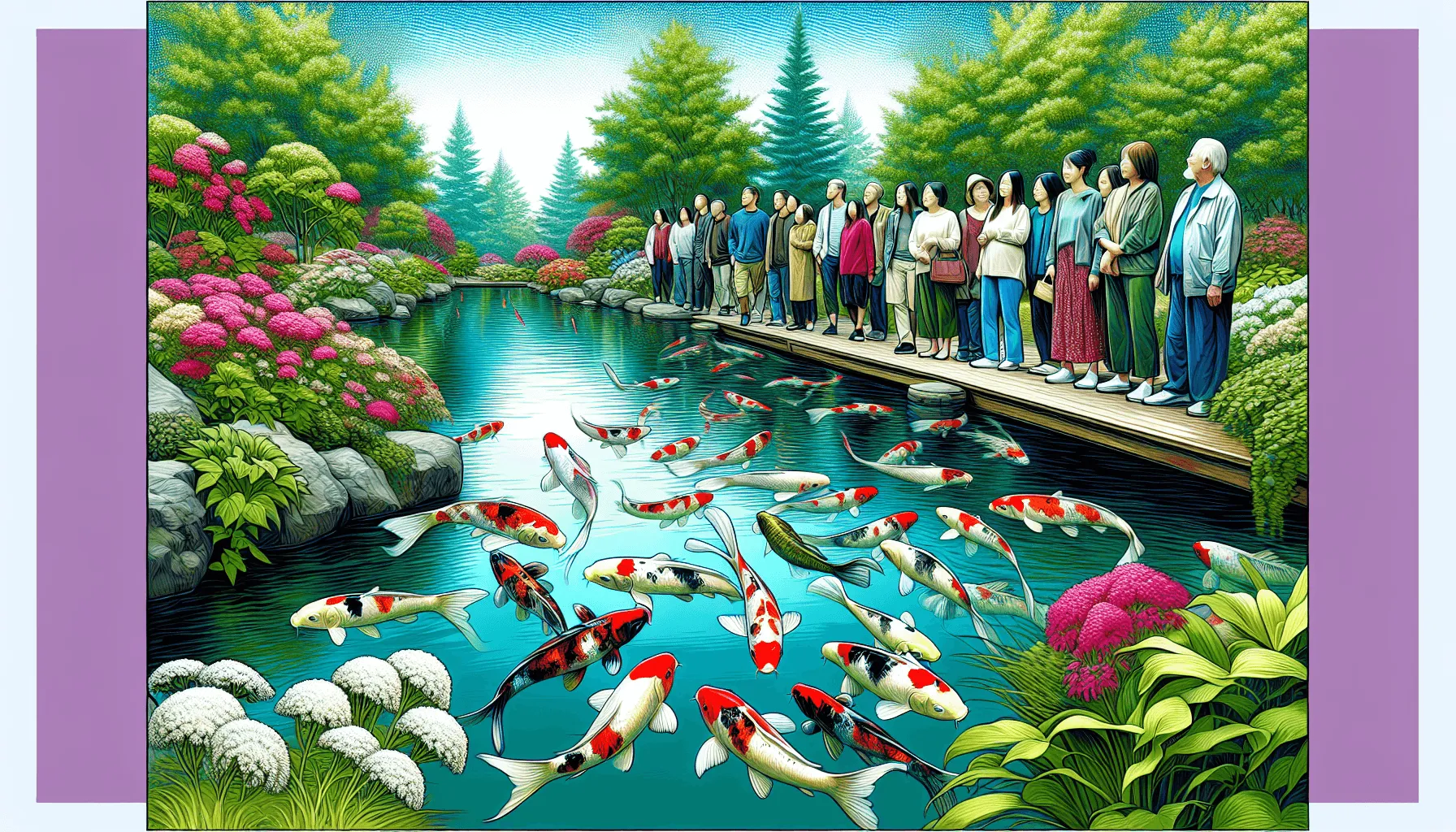Raising koi fish offers numerous benefits, from creating a tranquil outdoor space to the joy of watching these vibrant creatures thrive. Known for their striking colors and graceful movements, koi fish can transform any pond into a beautiful focal point. Additionally, koi ponds can provide therapeutic effects, offering a serene retreat right in your backyard.
In this article, we’ll cover:
- The basics of how to raise koi fish
- Essential tips for setting up and maintaining a healthy koi pond
- Best practices for feeding, breeding, and disease prevention
- Winter care tips to ensure your koi fish survive cold months
- Methods to protect your koi from predators and explore monetization options
By following these essential tips, you’ll be well on your way to becoming a pro at raising koi fish.
Understanding Koi Fish Basics: A Beginner’s Guide
Different Types of Koi Fish and Their Characteristics
Koi fish, known for their vibrant colors and intricate patterns, come in various species. Some popular types include:
- Kohaku: White-bodied fish with red markings.
- Taisho Sanke: White with red and black spots.
- Showa Sanshoku: Black with red and white markings.
- Asagi: Blueish-gray scales with a red underside.
Each species has unique characteristics, making them a delightful addition to your pond.
Behavioral Traits of Koi Fish
Understanding koi behavior is essential for optimal care. Koi are social and typically thrive in groups. They exhibit:
- Feeding Behavior: Active surface feeders, often coming up to the surface when food is present.
- Social Interaction: Peaceful and often swim together in schools.
- Territorial Behavior: Rarely aggressive but may establish territories during breeding.
Understanding Koi Metabolism for Better Care
Koi metabolism plays a crucial role in their health:
- Temperature Sensitivity: Metabolic rates increase with temperature. Maintaining a stable water temperature between 60-75°F is vital.
- Dietary Needs: Omnivorous diet preferences mean they need a mix of proteins, vegetables, and commercial pellets.
Proper understanding of these aspects ensures your koi thrive in their environment.
1. Setting Up Your Koi Pond: Creating an Ideal Environment for Your Fish
Creating the perfect environment for your koi fish starts with thoughtful pond design. The depth of your pond is crucial, especially for winter protection. A minimum depth of 4.5 feet ensures that your pond won’t freeze completely during colder months, safeguarding your koi.
Temperature regulation is another key factor. Koi thrive in water temperatures ranging from 60°F to 75°F. Extreme temperatures can stress your fish, making them more susceptible to diseases. A stable temperature is easier to maintain with a deeper pond, as it mitigates rapid fluctuations.
Key Considerations:
- Pond Depth:
- Minimum of 4.5 feet for winter protection
- At least 1.5 feet during warmer months
- Water Temperature:
- Ideal range: 60°F to 75°F
Additionally, consider incorporating about 50% shade in the pond area to protect koi from direct sunlight and prevent overheating. This can be achieved by integrating plant life not only for oxygenation but also to create natural hideouts and food sources. For instance, enhancing your koi pond with water lilies can provide both beauty and balance to the ecosystem.
By focusing on these pond depth and temperature requirements, you’ll set the foundation for a healthy and thriving environment for your koi fish.
Maintaining Water Quality: Ensuring a Healthy Habitat for Your Koi Fish
Keeping the water clean and balanced is crucial for raising healthy koi fish. Here’s how you can do it:
1. Test Water Regularly
Check the levels of ammonia, nitrite, and nitrate in your pond water often. These are chemicals that can harm your fish if they build up too much.
- Ammonia: Should always be zero. Even a little bit is bad for koi.
- Nitrite: Also needs to be zero.
- Nitrate: Not as dangerous but still needs monitoring.
2. Change Water Weekly
Replace about 10% of the pond water every week. This helps remove pollutants and adds fresh minerals back into the water.
By following these steps, you’ll create a safe and healthy home for your koi fish, helping them grow strong and live longer.
Optimal Feeding Practices: Nourishing Your Koi Fish for Growth and Vibrant Colors
Understanding koi feeding habits is essential for maintaining their health and enhancing their vibrant colors. Koi fish are omnivorous, enjoying a diverse diet that includes both commercial and natural foods.
Recommended Types of Food:
- Commercial Food: High-quality koi food pellets are designed to provide balanced nutrition. Look for brands that offer specific formulations for growth, color enhancement, and overall health.
- Natural Food: Incorporate vegetables like lettuce and peas, as well as fruits such as watermelon. Live foods like earthworms and insects can also be beneficial.
Feeding Guidelines:
To prevent overfeeding and subsequent pollution in the pond, adhere to these guidelines:
- Small Frequent Feedings: Feed your koi small amounts multiple times a day rather than one large feeding. This helps maintain water quality by reducing waste buildup.
- Monitor Eating Habits: Only give what your koi can consume in a few minutes. Leftover food should be removed to avoid it decomposing in the pond.
- Know When Not to Feed: It’s important to understand when you should not feed your koi fish. Factors such as water temperature, season, and the health of your fish can influence feeding.
Maintaining optimal feeding practices not only supports the growth and vibrancy of your koi but also plays a crucial role in keeping the pond environment clean and healthy.
Disease Prevention and Health Care: Keeping Your Koi Fish Happy and Disease-Free

Ensuring your koi fish remain healthy involves regular koi health monitoring. Detecting disease signs in koi fish early is crucial for effective treatment. Common indicators of illness include:
- Red sores
- Scratching against objects
- Lethargy or unusual swimming patterns
- Loss of appetite
Quarantine new additions to prevent potential disease spread. Regularly inspect your fish and consult a vet if you notice any abnormalities. Maintaining optimal water quality and cleanliness can significantly reduce the risk of infections.
Breeding Koi Fish: From Spawning to Raising Healthy Fry
Breeding koi fish requires specific conditions to ensure successful spawning and healthy fry. Begin by ensuring you have both male and female koi in your pond. A balanced ratio increases the likelihood of successful fertilization.
Creating Suitable Spawning Environments
- Hiding Spots: Incorporate areas with plants or spawning brushes to provide cover for the eggs.
- Water Quality: Maintain optimal water quality by regularly testing and adjusting pH, ammonia, nitrite, and nitrate levels.
- Temperature Control: Ideal breeding water temperatures range between 68°F to 75°F.
Protecting Eggs After Spawning
To protect the eggs from being eaten by adult koi, take the following steps:
- Remove Parents: Once spawning is complete, gently remove the adult koi from the pond.
- Egg Protection: Provide additional hiding spots within the pond or use a separate breeding tank.
Raising Koi Fry
After hatching, focus on how to raise koi fry to grow fast and healthy:
- Diet: Feed high-protein foods specifically designed for fry.
- Water Conditions: Keep water clean with frequent changes.
- Monitoring: Regularly check for signs of disease or stress.
Understanding these key points will help you successfully breed koi fish and raise vibrant, healthy fry.
Winter Care Tips: Ensuring Your Koi Fish Thrive During Cold Months
Taking care of your koi fish during winter is crucial to their survival. Keeping water temperatures stable above 10°C (50°F) prevents stress and health issues. Use a pond heater or de-icer to stop the water from freezing completely.
Key practices include:
- Reduce feeding: Koi metabolism slows in cold water, making frequent feedings unnecessary.
- Clean equipment regularly: Ensure filters and pumps are free of debris to maintain water flow and quality.
- Monitor oxygen levels: Ice can reduce oxygen exchange; using an aerator helps.
Proper winter care ensures your koi remain healthy through the cold months.
Protecting Your Koi Fish from Predators: Safeguarding Their Safety and Well-being
Protecting your koi fish from predators is essential for their safety. Common predators like herons and egrets can be deterred using various methods:
- Nets or Wire Mesh: Cover your pond with nets or wire mesh to create a physical barrier that prevents predators from reaching the water.
- Hiding Spots: Incorporate rocks, plants, and other structures within the pond to provide koi with places to hide from potential threats.
These preventive measures will help protect your koi and maintain their well-being.
Indoor vs Outdoor Koi Raising: Choosing the Right Method for You
When deciding between raising koi fish indoors or outdoors, consider several factors:
Space Availability
- Indoor Tanks: Require less space and are ideal for hobbyists with limited outdoor area.
- Outdoor Ponds: Offer more room for koi to swim and grow, best for larger properties.
Climate Control
- Indoor Tanks: Easier to regulate temperature and water conditions, protecting koi from extreme weather.
- Outdoor Ponds: Subject to seasonal changes, necessitating additional measures like pond heaters during winter.
Aesthetics
- Indoor Tanks: Can be integrated into home decor, providing a stunning visual centerpiece.
- Outdoor Ponds: Enhance garden landscapes, creating a serene environment that complements outdoor settings.
Both methods have unique benefits. Your choice depends on your space constraints, climate considerations, and aesthetic preferences.
Monetizing Your Koi Raising Hobby: Turning Passion into Profit
If you’re passionate about koi fish, why not turn that passion into profit? Raising koi for profit can be a rewarding venture with the right approach. Here are some ways to explore potential profitability in the koi market:
1. Breeding High-Quality Specimens
Focus on breeding premium quality koi fish. Selective breeding techniques can help you produce koi with desirable traits such as vibrant colors and unique patterns. These high-quality specimens often fetch higher prices in the market.
2. Selling to Enthusiasts and Collectors
Once you have high-quality koi, you can sell them to hobbyists and collectors. Platforms like local fish stores, online marketplaces, and koi shows are excellent places to showcase your stock.
3. Offering Koi Pond Services
In addition to selling fish, consider providing pond design, installation, and maintenance services. This adds an extra revenue stream while leveraging your expertise in koi care.
4. Participating in Koi Competitions
Winning awards at koi competitions can significantly increase the value of your fish. It also establishes your reputation as a reputable breeder.
5. Leveraging Online Platforms for Sales
With the rise of e-commerce, it’s now easier than ever to reach potential customers beyond your local area. Consider setting up an online store or utilizing platforms that specialize in selling live fish. This could significantly expand your customer base and increase sales.
By focusing on these strategies, you can effectively raise koi fish for profit and turn your hobby into a thriving business venture. Always remember to stick or twist when faced with tough decisions in this journey – sometimes holding onto a good thing is just as important as knowing when to let go and try something new.
Final Thoughts on Raising Healthy and Happy Koi Fish!
Raising koi fish requires dedication and a long-term commitment to their care. Focus on creating an ideal environment, maintaining water quality, and providing the best nutrition.
Key takeaways for successful koi raising tips:
- Consistent Water Quality: Regularly test and adjust water parameters.
- Balanced Diet: Feed your koi high-quality commercial food alongside natural options.
- Protective Measures: Use nets to safeguard against predators and provide hiding spots.
- Health Monitoring: Inspect regularly for signs of illness and quarantine new additions.
By following these guidelines on how to raise koi fish, you ensure a thriving habitat that promotes their health and longevity.
FAQs (Frequently Asked Questions)
What are the basic requirements for setting up a koi pond?
To create an ideal environment for your koi fish, ensure that your pond has a minimum depth for winter protection and maintains an ideal water temperature range for healthy growth. Additionally, proper pond design is crucial.
How can I maintain water quality in my koi pond?
Regularly test ammonia, nitrite, and nitrate levels in your pond water to ensure optimal conditions. It is recommended to perform a 10% water change weekly to maintain excellent water quality.
What should I feed my koi fish for optimal health?
Koi fish have omnivorous diet preferences. It is best to provide high-quality koi food and follow guidelines for small frequent feedings to prevent pollution in the pond while promoting growth and vibrant colors.
What signs indicate that my koi fish may be ill?
Look out for red sores, scratching against objects, or changes in behavior as signs of illness in your koi fish. Regular health monitoring is essential to keep them happy and disease-free.
How can I protect my koi fish from predators?
Using nets or wire mesh can effectively safeguard your koi from common predators like herons and egrets. Implementing these protective measures is vital for ensuring their safety and well-being.
Is it more beneficial to raise koi indoors or outdoors?
The choice between raising koi indoors or outdoors depends on factors like space availability, climate control, and aesthetics. Each method has its advantages, so consider your specific circumstances before deciding.




